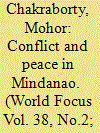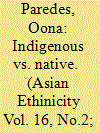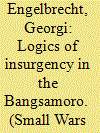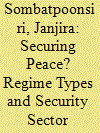| Srl | Item |
| 1 |
ID:
150605


|
|
|
|
|
| Summary/Abstract |
The year 2014 will be commemorated in the history of Southeast Asia in general and the Philippines in particular as the year marking the almostpenultimate step towards the finale of a protracted separatist movement in the southern island of Mindanao, since the “Comprehensive Agreement on the Bangsamoro” was signed in Manila in March. Conceived as a nationalist struggle, aimed at the establishment of an autonomous homeland for the thirteen ethno-linguistic groups comprising the Philippine Muslims (‘Moros’), the historical roots of this movement run deep into the labyrinths of the colonial era. As a dominant group with a five-century old civilizational heritage, the Moros account for about 20% of the entire population of the Philippines and were originally concentrated in the southern provinces of the country.
|
|
|
|
|
|
|
|
|
|
|
|
|
|
|
|
| 2 |
ID:
137221


|
|
|
|
|
| Summary/Abstract |
Two categories of ethnic minority – Moro and Lumad – are indigenous to the Philippine island of Mindanao, with Muslim Moros outnumbering largely animist Lumads. Both have been profoundly displaced by the post-World War II influx of Christian Filipino settlers from other islands, leading to armed conflict with the national government over land and political control. Due to their political and demographic inferiority to Moros, Lumads have regularly resorted to the accommodation and assimilation of Moro priorities, including throwing their support behind the latters’ decades-long struggle for territorial autonomy. Thanks to wide public support among the Lumad and other Mindanao sectors, the latest peace talks between the government and Moro leaders has led to the signing of a major peace deal involving the creation of a new autonomous Bangsamoro homeland. Despite this, the legitimate needs of Lumad stakeholders have been ignored, and in some cases deliberately undermined, by Moros and the national government. This article analyses the post-conflict status of the Lumad who, as second-order minorities in the future Bangsamoro homeland, have been doubly marginalized in daily life and in the peace process. It concludes that denying Lumad concerns now will render Bangsamoro more vulnerable to legal and constitutional challenges, as well as jeopardize the unique ‘tri-people’ ethos that has made this the most firmly grounded peace process to date.
|
|
|
|
|
|
|
|
|
|
|
|
|
|
|
|
| 3 |
ID:
183457


|
|
|
|
|
| Summary/Abstract |
Over sixty years of conflict in the Southern Philippines, between the government and separatist groups, have made Mindanao and the Sulu Archipelago an area prone to violence. Armed groups in Bangsamoro and their historical antecedents have often local origins. Even the original rebellion of the Moro National Liberation Front (MNLF) from which the Moro Islamic Liberation Front (MILF) emerged, the largest rebel force in the area and current leader of a transition government in the Bangsamoro, was a coalition of armed elements across Mindanao that organized together before becoming a stronger united front. The following article will describe the evolution of the armed rebellion in Mindanao and analyse its subsequent trajectory, proposing four reinforcing lenses to understand the various Moro insurgencies and explain local splintering and contradictions within the rebel movement.
|
|
|
|
|
|
|
|
|
|
|
|
|
|
|
|
| 4 |
ID:
160663


|
|
|
|
|
| Summary/Abstract |
This article examines how regime types shape security sector reforms, that are integral to the peace processes in Thailand’s Patani and the Philippines’ Mindanao. Lessons drawn from Thailand and the Philippines, illuminate the interplay between regime types and peace processes and reveal that: (1) democratic regimes tend to address aspects of security sector reform; (2) military regimes may cherry-pick a security agenda for tactical reasons, while turning peace talks into ‘ceremonial structures’; (3) weak democratic institutions are not necessarily amenable to security sector reform, but democratic spaces can empower civil society to propel security actors to embrace some degree of reform.
|
|
|
|
|
|
|
|
|
|
|
|
|
|
|
|